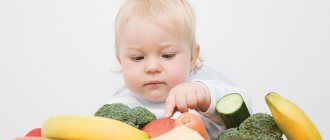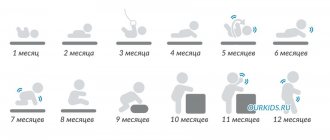Is it necessary and how to properly introduce complementary foods at 4 months while breastfeeding?
Even now, many pediatricians argue with each other regarding complementary feeding of children who eat mother's milk. Previously, it was possible to introduce fruit juices into a child’s diet starting from the age of one month. It did not matter whether the baby was breastfed or bottle-fed.
But a lot of allergic reactions occurred, and later researchers determined that such a young body was not yet able to completely process and absorb the beneficial substances of the juice.
The same debate arose with the use of chicken yolk. First of all, it is worth understanding that the yolk was given as a source of vitamin D, now children are given Aquadetrim, so there is no need to give the yolk. This product is also a strong allergen.
According to WHO, children who are fed breast milk and gain at least 500 g per month do not need complementary feeding until 6 months. That is, introducing complementary foods at 4 months is out of the question. This can cause a decrease in the mother's milk supply and the development of allergies in the baby.
introduce complementary foods at 4 months while breastfed
Where to begin?
Pediatricians often differ in their opinions on this topic - some say that you should start with cereals, others are sure that you should definitely start with fruits, and still others say that vegetables are ideal for introducing a baby to “adult” food. And absolutely all of these judgments are true, and they can be easily explained. After all, pediatricians recommend a certain type of first complementary feeding for an individual child, based on the problems that the early introduction of new products should solve.
If the child is on an artificial type of feeding, and has problems with excess weight, then introducing complementary foods at 4 months will even be useful. It is better to start with vegetables, as they are lower in calories and do not affect weight gain.
If the artificial child does not have problems with weight, you can start feeding either vegetables or cereals, at the discretion of the parents. When a child is severely underweight, the baby often wakes up at night from hunger, then you should start with cereals.
The same principles of introducing new foods apply to babies who are breastfed. If up to 4 months the baby received formula as supplementary feeding, upon reaching this age you can replace it with porridge. The main thing to remember is that you still can’t stop breastfeeding your baby.
You should start complementary feeding with fruits only if you are prone to constipation. Prunes are especially helpful and can be included in a child’s menu at this age. In other cases, introducing fruits first can play a cruel joke on parents - sometimes the child does not want to eat bland vegetables after them.
What foods can you give?
Homemade zucchini puree for baby's first feeding
Not all vegetables, fruits and cereals can be used in a baby’s diet. The list of such vegetables is small:
- zucchini;
- cauliflower;
- broccoli.
These vegetables are less allergenic and easier for the stomach to digest than others. As for cereals, dairy-free cereals that do not contain gluten are used for the first complementary feeding:
- buckwheat;
- rice;
- corn
A 4-month-old baby's diet can be varied with fruits - applesauce is usually the first to try, then prunes, pears or peach can be introduced.
Replenishing the diet: what to give and how much?
If you do not know the basic rules for introducing new foods into the diet of a four-month-old baby, you can provoke allergies, colic, or bowel disorders. First of all, you should remember that at 4 months a baby cannot eat meat, fish, exotic and citrus fruits, red vegetables, sweets and chocolate. True, this does not mean that other products can be given to the baby in unlimited quantities.
- If replenishing your diet begins with purees, no matter fruit or vegetable, the main thing to remember is that they must consist of one component.
- It is better to choose porridges that are dairy-free and do not contain any additives.
- Multi-component purees and cereals are introduced into the baby’s diet after 6 months.
- The first feeding should be in semi-liquid form and offered to the baby from a spoon.
The timing of the introduction of a new product is also of particular importance. It is best to try something new at lunchtime before the main meal, i.e. before breastfeeding or formula feeding. Moreover, on the first day it is correct to offer the baby no more than 1 teaspoon. With each subsequent day, the portion increases by 2 times until the amount of food the baby eats reaches 100 - 120 grams and replaces one full feeding. Only after one product has been completely introduced can the next one begin to be introduced, and this scheme is suitable for each product. This way, a 4-month-old baby’s menu will become more varied every week.
What is better: buy or cook?
Baby apple puree FrutoNYANYA for complementary feeding of a child from 4 months
You can prepare puree or porridge yourself, or you can buy it in a specialized department. If parents decide to prepare food for their child, it is better to use vegetables and fruits that they grow themselves. Store-bought ones, especially those bought in the cold season, are probably “stuffed” with chemicals. The same applies to store-bought frozen vegetables and vegetable mixtures.
Baby food should not be fatty, not spicy, not salty and not sweet. Frying and baking food for children is also prohibited. When preparing purees for a four-month-old baby, you cannot use vegetable oil, much less butter. This can be done in a couple of months, when the baby’s body gets used to “different” food.
All vegetable and fruit purees are prepared according to the same recipe:
- 100 g of raw vegetable;
- 2 tbsp. l. water, breast milk or formula.
The vegetable or fruit is cooked until tender; it’s not even scary to overcook it (this will make it easier to chop). You can also steam it, whichever is more convenient for parents. After this, add liquid to the vegetable or fruit and grind with a blender (or mash with a fork) until smooth and porridge-like.
You cannot add salt, pepper or sugar to dishes for four-month-old babies. A child's taste buds are not yet the same as those of adults. By neglecting this rule, parents themselves instill in their children the wrong eating habits.
How to properly introduce complementary foods at 4 months on artificial feeding?
Formula-fed babies need complementary feeding as early as 4 months. This is due to the lack of vitamins and minerals contained in the mixture. Because of this, problems with stool may occur; the baby often spits up and does not eat enough.
The pediatrician will tell you what is best to give your baby as complementary food. But usually vegetable puree or porridge is introduced first. The choice of one option or another depends on how well the child is gaining weight. If the baby weighs little and eats formula very poorly, porridge is introduced. They are higher in calories and contribute to weight gain. If the baby is “fat”, then vegetable puree is introduced. It is best to give pureed zucchini or broccoli. They are easily digestible and do not cause allergies.
correctly introduce complementary foods at 4 months on artificial feeding
Menu for a bottle-fed baby
Introducing new foods can start with fruit juices and purees or cereals. At 5 months, the formula-fed baby’s menu includes not only vegetable purees, but also milk porridges. You can add a little vegetable or butter to both. At this age, you can give up to 150 g of vegetable puree or 50–100 g of milk porridge in addition to dry mixture, as well as juices and purees, to which the child’s body has already adapted. Vegetable puree is usually prescribed as the first complementary food. For children with insufficient weight gain and unstable stools, the first type of complementary food may be porridge. Complementary foods should be introduced gradually, starting with one product.
Grain complementary foods (porridge) are one of the main sources of carbohydrates, vegetable proteins and fats, dietary fiber, iron, selenium, vitamins B1, B2, PP, etc.
Grain-based complementary feeding should begin with gluten-free cereals (rice, buckwheat, and later corn). Porridges can be dairy or dairy-free. The latter are diluted with breast milk, infant formula received by the child or cow's milk. In the future, gluten-containing porridges (oatmeal, barley, wheat, semolina) and porridges made from a mixture of cereals can be used.
Vegetable puree is a source of organic acids, potassium, iron and dietary fiber, including pectins. Certain types of vegetables (carrots, pumpkin, spinach, etc.) are rich in carotene, a precursor of vitamin A. Initially, vegetable puree should consist of one type of vegetable with delicate fiber, for example, zucchini. Next, it is advisable to use a combination of 3-4 vegetables.
From 5–6 months, cottage cheese is introduced into the child’s diet, which is a source of complete protein and calcium. Cottage cheese is introduced into the child’s diet in small quantities. The dose is gradually increased and after 3-4 days it is increased to 20 g per day in one or two doses, then to 40 g and by the year - to 50 g per day. From 6 months, you can introduce egg yolk into your baby’s diet. From 6 months - ¼, from 8 months. - ½ yolk of a hard-boiled chicken egg. It must be carefully separated from protein, which is not given to children under 1 year of age, as it is difficult to digest. The yolk can be given simultaneously with milk porridge or vegetable puree. However, children with food allergies should not be given yolk, since ovalbumin is a strong allergen. It is recommended to introduce meat into a child’s diet from 7 months with natural feeding and from 6 months with artificial feeding. In some cases, if the child is lagging behind in development, there are manifestations of rickets, anemia, meat can be given earlier (at 5.5 or even 5 months along with vegetable puree).
From 8–9 months. Vegetable soups can be introduced into the child’s diet. Soups are used as a first course when the child’s lunch is already being formed. They are given in small quantities of 30–50 ml to stimulate appetite. Fish is introduced into a child’s diet from 9–10 months. Fish is a very healthy product, as it contains easily digestible protein and is rich in phosphorus, which, together with calcium, is involved in the construction of bone tissue. Fish is also rich in vitamins A, D, B6, B12, and pantothenic acid. Fish should be introduced into a child’s diet very carefully, starting with very small quantities, preferably in the morning, carefully observing the child’s reaction. At this time, no other new types of food (other types of fruits, vegetables, juices, meat) should be introduced into his diet in order to correctly assess the tolerability of the fish dish.
As the child grows older, the volume of complementary foods, of course, should increase - the body adapts to the intake of new food and requires more and more energy for active growth and development.
Experts have developed an approximate scheme for introducing complementary foods for formula-fed babies.
However, for each bottle-fed child, an individual menu must be drawn up. To do this, be sure to seek help from a pediatrician who will assess the developmental characteristics and health status of your baby. Proper complementary feeding is a reliable foundation for the healthy growth and happiness of a child.
#PROMO_BLOCK#
Find out more about formula-fed complementary feeding on our blog.
Vegetable feeding at 4 months - what vegetables and how to introduce them?
It is best to choose light-colored vegetables as the first vegetable puree. Zucchini, cauliflower and broccoli are ideal. To begin, add cold water to the vegetables and bring to a boil. After this, boil until done.
Salt, pepper, sugar and butter should not be added to the mixture. Next, the boiled vegetables are crushed in a blender and the broth is added to make the puree liquid. It is recommended to introduce a new vegetable every three weeks. Be sure to watch the reaction.
If your baby vomits, spits, or expresses indignation, delay introducing solid foods. Under no circumstances should food be given from a bottle. Vegetable purees, even if they have a liquid consistency, should be given from a spoon.
Vegetable feeding at 4 months
Menu in table form for each day of the week by hour
If the baby has already been introduced to all of the above products, then you can stick to the following menu (time may vary by 1-2 hours, according to the individual daily routine):
| Monday | Tuesday | ||
| 6.00 | Adapted infant formula, 180ml | Adapted infant formula, 180ml | |
| 9.00 |
|
| |
| 13.00 |
|
| |
| 17.00 |
|
| |
| 21.00 | Adapted mixture - 200 ml. | Adapted mixture - 2000ml | |
| Night feeding is purely individual, at the request of the child. | |||
| Wednesday | Thursday | |||
| 6.00 | Adapted infant formula, 180ml | Adapted infant formula, 180ml | ||
| 9.00 |
|
| ||
| 13.00 |
|
| ||
| 17.00 |
. |
| ||
| 21.00 | Dairy-free rice porridge - 200g. | Adapted mixture - 200 ml. | ||
| Night feeding is purely individual, at the request of the child. | ||||
| Friday | Saturday | |||
| 6.00 | Adapted infant formula, 180ml | Adapted infant formula, 180ml | ||
| 9.00 |
|
| ||
| 13.00 |
|
| ||
| 17.00 |
|
| ||
| 21.00 | Adapted mixture - 2000ml | Dairy-free rice porridge - 200g. | ||
| Night feeding is purely individual, at the request of the child. | ||||
| Sunday | ||||
| 6.00 | Adapted infant formula, 180ml | |||
| 9.00 |
| |||
| 13.00 |
| |||
| 17.00 |
| |||
| 21.00 | Adapted mixture - 200 ml. | |||
| Night feeding is purely individual, at the request of the child. | ||||
How much vegetable puree should a 4 month old baby eat?
If you decide to introduce complementary foods, you should not immediately replace the intake of the mixture with vegetables. Before the next meal, you need to offer your baby a teaspoon of puree and supplement it with the mixture, that is, give 150 ml of the mixture.
On the second day, give 2 spoons of puree, the mixture already needs 130 ml. So gradually increase the amount of puree. In a week you will be able to completely replace one dose of 150 ml of the mixture with vegetable puree. It also needs to be given 100-150 ml. Do not mix vegetables to make puree.
Introduce complementary foods in the morning and monitor the baby’s well-being. If you experience bloating, restlessness, and loose stools, delay introducing complementary foods.
How much vegetable puree should a 4 month old baby eat?
Sample menu
What to feed a child at 4 months is not a difficult question, because the baby’s menu does not change much. At this age, he is just beginning to become acquainted with adult food. There are many tables on the Internet that detail a child’s nutrition plan. But their essence is the same - the introduction of a new product occurs during lunch. The remaining meals remain unchanged.
The only thing that can still change is how long the next feeding will be after a full portion of complementary foods. After all, a full portion of “adult” food helps saturate the body for a longer period of time than 3 - 3.5 hours.
Some sources report that the baby’s diet needs to be replenished with vegetable and fruit juices, but this is nothing more than relics of the past. Previously, about 20 years ago, pediatricians believed that the vitamins that a baby receives from mother’s milk are not enough for normal growth and development.
Over time, research has shown that a baby can be exclusively breastfed for more than 6 months without experiencing nutritional deficiencies. Juices have a detrimental effect on the baby’s stomach, so they are introduced into the diet no earlier than 6 months, and the WHO does not recommend until 1 year.
What kind of porridge and how can you give it at 4 months?
Porridge is a popular type of complementary food among babies who have trouble gaining weight. Typically, such children have loose stools, are constantly worried and do not recover well. Under no circumstances should you introduce semolina; this porridge is the most useless of all. It contains very few vitamins and minerals.
It is recommended to give rice or buckwheat porridge. Oatmeal is recommended if the child does not have a reaction to gluten. Initially, porridge is cooked in water without adding salt or oil. The consistency of the porridge is very liquid. If the baby was previously given cow's or goat's milk and there is no reaction, then it is allowed to cook porridge with milk, after diluting it half and half with water.
The best porridges:
- Gluten-free
- Dairy-free
- One-component
They can be purchased or you can make them yourself by chopping ready-made porridge with the addition of cereal broth.
What kind of porridge and how can you give it at 4 months?
Regime and diet of a 4 month old child: complementary feeding scheme
The main thing is not to rush with complementary foods. First you need to understand that at 4 months a child should eat 5-6 times a day, that is, the break between meals is 3 hours. In the morning, formula milk is given. After this, after 3 hours, complementary foods are introduced in an amount of 20-150 g. The mixture is given in proportion to the weight of the complementary foods. That is, if you gave 50 g of puree, then you need to give 100 ml of the mixture.
At this age, you cannot replace the mixture with vegetable puree for more than one meal. The calorie content of purees is low and the child may begin to lose weight. In addition, problems with stool are possible.
complementary feeding scheme
Feeding rules
A grown-up baby at the age of 4 months still needs properly selected nutrition; it would be advisable to continue feeding the baby with an adapted infant formula. This is the best, balanced and high-quality replacement for breast milk, developed according to all the rules, where all the slightest nuances are taken into account, and the composition is as similar as possible to breast milk.
Mode
For 4-month-old children receiving food in the form of artificial feeding, it is imperative to strictly follow the regimen, since adapted infant formula is absorbed much more slowly by the baby’s body, unlike breast milk , so the little one remains full much longer.
Important! The break between meals should be at least 3.5 hours. If you do not follow the feeding rules, this will cause gas formation in the child’s body.
Also, starting from the 4th month, many pediatricians advise formula-fed babies to start complementary feeding.
How to feed?
At 4 months of age, the baby cannot yet sit up on his own, so new parents should make sure that the baby is comfortable while eating. You should only feed your baby with a spoon. At the same time, he should be in a reclining state so as not to harm the fragile spine. Modern children's high chairs are equipped with this function; it will be convenient for the baby to eat and for the mother to feed him.
Young mothers should definitely stock up on additional equipment, that is, they need to purchase special dishes for the child:
- spoon with a silicone scoop - the baby will not be able to damage the oral cavity with it;
- bib, so as not to stain the toddler’s clothes;
- the plate on the suction cup will definitely not be knocked over on the floor;
- a cup that the little fidget cannot break,
It is from 4 months that the baby actively begins to explore the world around him. In addition, this will be excellent training for independent eating.
A newborn child does not yet have any teeth at all or partially and the baby is not able to chew solid food, so the consistency of food intended for the child should be liquid or puree-like.
How much should a four month old baby eat?
At the age of 4 months, the daily food intake is no more than 1000 ml. per day. The number of feedings is 5-6 times. Under no circumstances should you exceed it, as this can be fraught with unpleasant consequences.
Note! Before introducing complementary foods, consultation with a specialist is recommended.
Baby menu at 4 months
Here is a sample menu:
- 6.00: breast milk or adapted formula
- 10.00: milk or mixture and fruit juice (apple or peach)
- 14.00: mixture and puree of vegetables (zucchini, broccoli)
- 18.00: mixture and fruit puree.
- 22.00: mixture plus egg yolk (1/4 part yolk)
- Before putting your baby to bed, feed him formula.
There is no need to try to cram as much fruit and adult food into your child as possible. The baby's digestive system is not quite ready for this. As a result of improper complementary feeding, disruptions in the functioning of the digestive system may occur.
Baby's menu at 4 months
As you can see, ideally it is better to breastfeed your baby until 6 months. With normal weight gain, the baby does not need complementary feeding. In bottle-fed babies, complementary foods are introduced at 4 months.
Diet features
The diet of a formula-fed newborn at four months increases significantly if complementary foods are actively introduced.
What can be given at this age?
The main and main product still remains an adapted infant formula. Also, new products appear on the menu of a 4-month-old baby. Several types of cereals (gluten-free and dairy-free cereals), vegetable and fruit purees and juices.
What products are allowed to be introduced?
Although baby formulas intended for feeding a child are enriched with many useful elements, they are still not always enough for a growing body. This is where products filled with vitamins and microelements will help. It is allowed to introduce into the diet of a bottle-fed toddler, on the recommendation of a pediatrician, in the 5th month of life:
3 cereals:
- Buckwheat.
- Corn.
- Rice.
Several vegetables:
- Zucchini.
- Cauliflower.
- Broccoli.
Fruits:
- The apple is green.
- Pear.
- Peach.
- Banana.
And of course juices and compotes:
- Apple juice.
- Pear.
- Carrot.
- Dried fruits compote.
Important! Red and orange fruits are more likely to cause allergies, unlike green and yellow ones.











